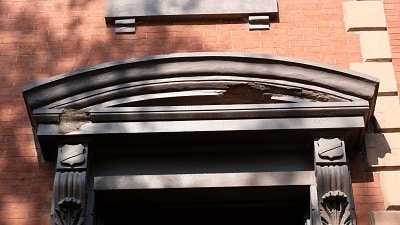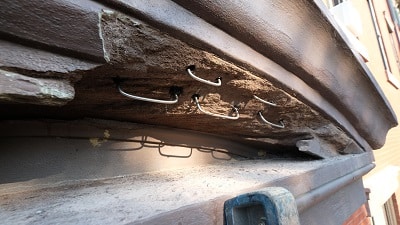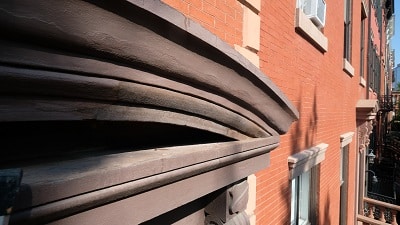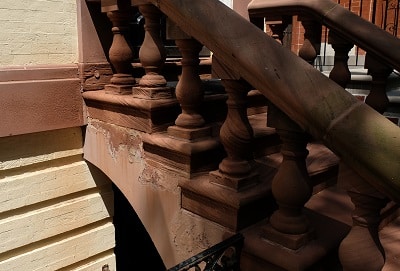Marcin Pikus, Conservator of Stone Sculpture and Architectural Features, provided some emergency conservation repairs for the crumbling exterior sandstone of the President’s Guest House, also known as the Blair House, in Washington, DC. He also conducted a condition survey of a number of entryways, balustrades, lintels, and steps, all made of Belgian brownstone or sandstone.
Though the brownstone architectural features are not particularly old, the material has some inherent issues which are exacerbated by the variable D.C. climate. For example, the stone is porous and readily absorbs water, so the yearly freeze-thaw cycles have caused spalling. A coating of latex paint also trapped moisture inside, making the condition issue even worse. Large pieces from one of the lintels broke off and fell to the ground, creating a safety hazard for passers-by. It was clear that immediate conservation treatment of the brownstone was needed.


Pikus first had to remove any weak, crumbling stone around the loss to create a solid foundation for the repair. Stainless steel pins were inserted with epoxy which will help hold the repair in place. Color-matched stone restoration mortar was used to fill the loss and Pikus carved the fill to match the contours of the missing stone.

For the second part of this brownstone treatment, the conservator closely inspected a number of other entryways for any potentially hazardous conditions. Cracks, rust stains, black and green stains from micro-organisms, spalling, flaking paint, severe wear, and crumbling could be found in many areas. These observed condition issues will be addressed in a more comprehensive treatment plan for further stone conservation.

The Blair House was built in 1824 for Dr. Joseph Lovell, the first United States Army Surgeon General. During Andrew Jackson’s presidency, Francis Preston Blair, his wife Eliza and their three children, a family from Kentucky, moved in and the house became known as The Blair House.
Before Franklin Roosevelt’s presidency, visitors would often stay in the White House. When Winston Churchill attempted to enter the private residence of Eleanor and Franklin Roosevelt at 3:00 am to have a chat, Roosevelt recognized the need for a separate building to accommodate visitors to the White House.
Francis Blair had built a house next door for his daughter and her family, known as the Lee House. This house as well as two other buildings were annexed, and they are collectively called The President’s Guest house. The structures are all joined internally, but they maintain separate and unique outdoor facades.
